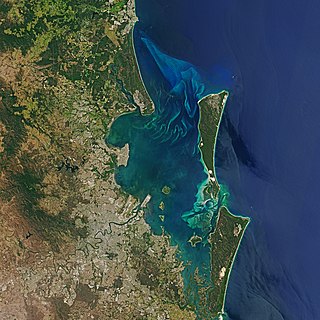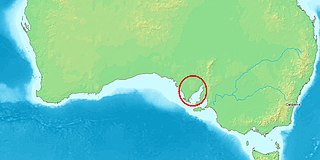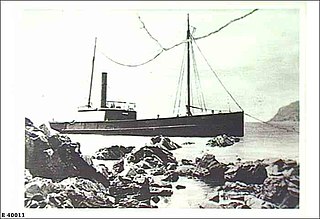
Moreton Bay is a bay located on the eastern coast of Australia 14 kilometres (8.7 mi) from central Brisbane, Queensland. It is one of Queensland's most important coastal resources. The waters of Moreton Bay are a popular destination for recreational anglers and are used by commercial operators who provide seafood to market.

The Spencer Gulf is the westernmost and larger of two large inlets on the southern coast of Australia, in the state of South Australia, facing the Great Australian Bight. It spans from the Cape Catastrophe and Eyre Peninsula in the west to Cape Spencer and Yorke Peninsula in the east.

The Eyre Peninsula is a triangular peninsula in South Australia. It is bounded by the Spencer Gulf on the east, the Great Australian Bight on the west, and the Gawler Ranges to the north.

SS Makambo was a steamship first owned by Burns Philp & Co. Ltd. She was built in Port Glasgow in Scotland and named after an island in the Solomon Islands. She carried both passengers and cargo and was principally used on routes between eastern Australia and islands in Melanesia and the Tasman Sea. In November 1908 Jack and Charmian London travelled from Guadalcanal to Sydney on the Makambo after abandoning their ill-fated circumnavigation of the world on the Snark, a 45' sailing yawl.

The Sea Shepherd Conservation Society engages in various demonstrations, campaigns, and tactical operations at sea and elsewhere, including conventional protests and direct actions to protect marine wildlife. Sea Shepherd operations have included interdiction against commercial fishing, shark poaching and finning, seal hunting and whaling. Many of their activities have been called piracy or terrorism by their targets and by the ICRW. Sea Shepherd says that they have taken more than 4,000 volunteers on operations over a period of 30 years.

Ellen was a steamship that was launched in 1883 and whose career involved coastal shipping firstly in the Colony of Queensland and then in the Australian state of South Australia. It was wrecked in Gulf St Vincent in South Australia at Morgan's Beach near the town of Cape Jervis on Saturday, 12 December 1908 during its return from fishing in waters around Kangaroo Island to a destination on the mainland.
Tumby Island is a low bedrock island located 500 m (1,600 ft) east of the southern tip of Tumby Bay in Spencer Gulf, South Australia. The island is a conservation park comprising 35 ha.

Louth Island is a 135 ha island located in Louth Bay, Spencer Gulf, South Australia. The island is privately owned, and has previously been used for the grazing of sheep and mining of guano. The island has an old building with sleeping quarters, several beaches, inshore rocky reef and a boat anchorage. It is 17.5 km NNE of Port Lincoln and is easily accessible by boat. The indigenous name for the island is Yorunu.
Grantham Island is an uninhabited island occupying 51 hectares of Proper Bay, Spencer Gulf, South Australia. The nearest geographical feature on the mainland is Murray Point, which is also undeveloped. The island was named by explorer Matthew Flinders on 25 February 1802, after the municipal and parliamentary borough of Grantham, Lincolnshire, England. It lies 3 kilometres south of the Port Lincoln marina and is well vegetated.
Boston Island is a 960-hectare (2,400-acre) privately owned island in Boston Bay, Spencer Gulf, South Australia. It has been primarily used for grazing sheep and was also once the location of a proposed township called Kerrillyilla at the southern end of the island. In 2009, the island was rezoned to allow for future residential and tourism development. As of 2009, it is owned by the former mayor of Port Lincoln, Peter Davis. Davis' development plans include up to 1,000 residential allotments, three tourism developments and an inland marina. Prior to rezoning, there had been little interest expressed in the development plan, despite the then mayor's enthusiasm.

A total of 24 people have been killed by sharks in South Australian waters since the establishment of the colony in 1836. Prior to 2014, there had been 82 recorded shark attacks in South Australia. 20 of those have involved a single fatality. Victims were involved in a range of aquatic activities, including surfing, diving, spear-fishing, snorkeling, boating and swimming. Six of the fatalities occurred off the coast of greater metropolitan Adelaide, with the remainder distributed across South Australia's extensive coastline. Many of the fatal attacks have been attributed to great white sharks.

The 1804 Antigua–Charleston hurricane was the most severe hurricane in the American state of Georgia since 1752, causing over 500 deaths and at least $1.6 million (1804 USD) in damage throughout the Southeastern United States. Originating near Antigua on 3 September, it initially drifted west-northwestward, soon nearing Puerto Rico. Throughout its existence in the Caribbean Sea, the hurricane damaged, destroyed, and capsized numerous ships, and at Saint Kitts, it was considered to be the worst since 1772. By 4 September, the storm arrived at the Bahamas and turned northward before approaching the coast of northern Florida on 6 September. The hurricane eventually came ashore along the coastline of Georgia and South Carolina while producing mostly southeasterly winds. A severe gale was noted in New England later that month, on 11 and 12 September, although it was likely not the same system as that which had passed through the Caribbean and southeastern United States earlier that month.
TSS Lorina was a passenger vessel built for the London and South Western Railway in 1918.

The Stone Fleet was the colloquial name for the small coastal ships that carried crushed-stone construction aggregate to Sydney from the Illawarra ports of Kiama and Shellharbour and the nearby ocean jetties at Bombo and Bass Point.
Spilsby Island is one of the largest islands in the Sir Joseph Banks Group in Spencer Gulf, South Australia. It is privately owned, has no permanent human residents and is grazed by sheep. The island was used for the breeding of sheep by James Hunter Kerrison, then for the breeding of horses, sheep, pigs and cattle by W. E. Scruby in the early 20th century. Shearers travelled to the island to shear the sheep. The island's soil has been enriched by the deposition of guano by seabirds. Land allotments and a few shacks are concentrated along the northern coast of the island. Butterfish Bay is on the northern coast and Hawknest Bay is on the eastern coast.












